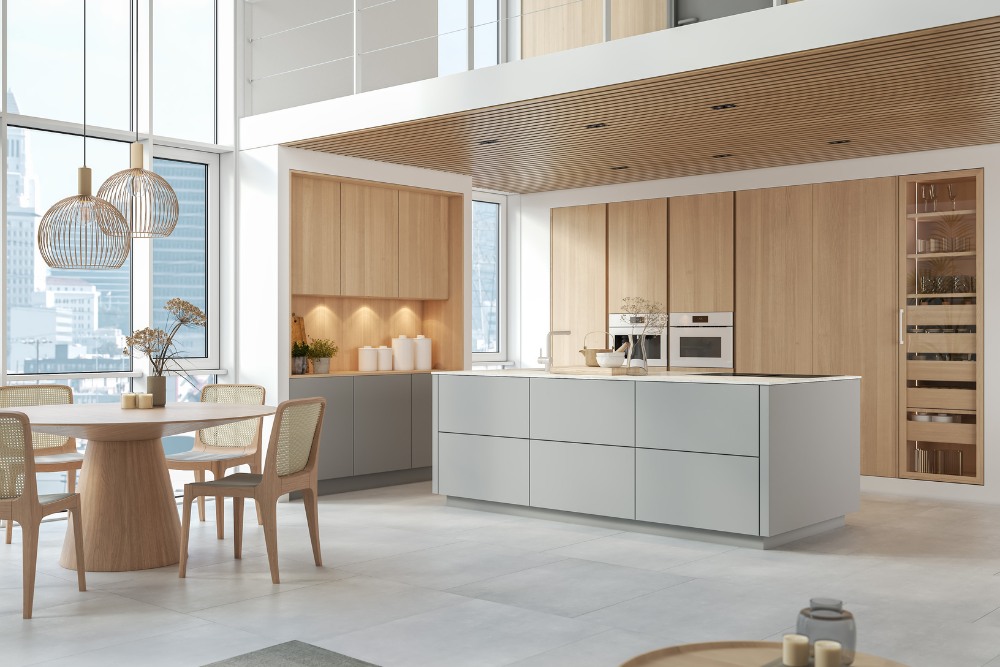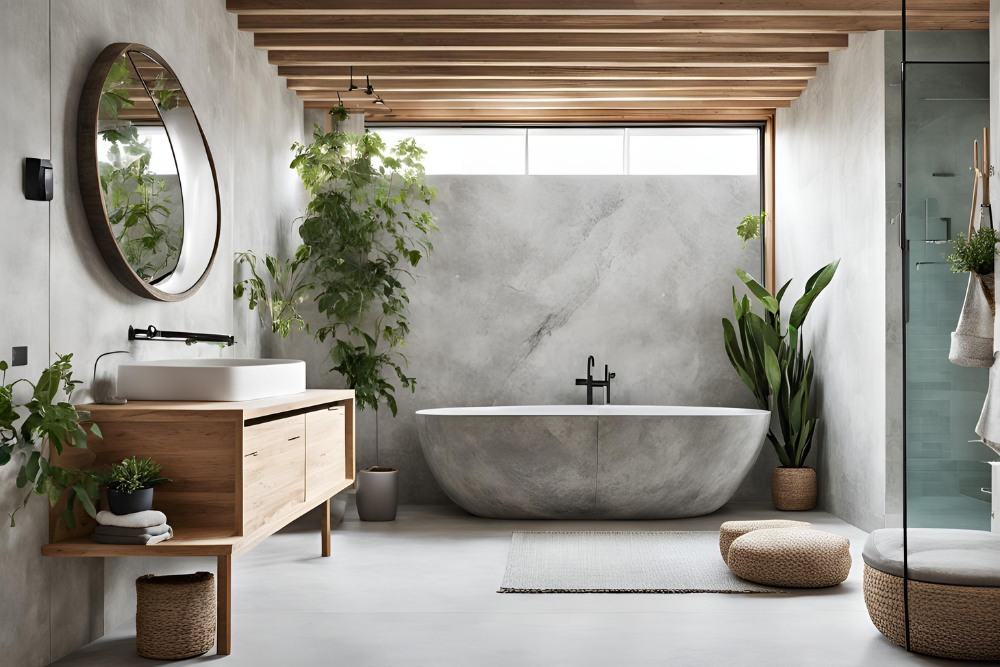Give Your Home a Minimalist Yet Cozy Makeover with Japandi Style
Are you wondering or thinking about for a while “What is the Japandi style?”
Japandi style is my personal favourite and the perfect interior design trend for Australians who want to create a minimalistic yet cozy, warm, and inviting home environment.
Japandi combines the zen minimalism of Japanese design with the natural, rustic elements of the Scandinavian style.
When you bring these two design aesthetics together in your home decor, it results in interiors that are soothing, simplistic and connected to nature.

List of Ideas for a Cozy Makeover with Japandi Style
Minimalist Yet Cozy Makeover with Japandi Style
In this blog post, we’ll explore everything you need to know to give your home a Japandi-style makeover.
Suppose you are looking for everything about Japandi style on one page. Read on to learn about the history of Japandi, its defining characteristics, colours, and materials to use, as well as tips for integrating Japandi into every room of your home.
With Japandi’s focus on simplicity, functionality and natural materials, it’s an interior design style well-suited for Australian homes and lifestyles.
You have a few more questions like “How to decorate the Japandi style?”, “How to create Japandi style?” Continue reading till the end to find out all of your question answers.
This post will explore some amazing ideas for a Cozy Makeover with Japandi Style.
What is the Japandi style?
The Origins and Principles of the Japandi Style
Japandi is a relatively new interior design style, first emerging in the 19th century and gaining popularity in recent years.
It brings together the Japanese aesthetic principles of minimalism, simplicity and restraint with the Scandinavian emphasis on natural materials, functionality and family life.

What are the elements of the Japandi interior design?
Some fundamental principles that define the Japandi style:
Minimalism: To achieve minimalism, eliminating clutter and focusing on essential items in a space. In my experience, maximum open space, and having light space are highly encouraged.
Natural Materials: One of the key components of the Japandi style is natural materials, such as wood, stone, rattan, linen and jute are heavily utilised. These materials connect the home to nature.
Neutral Color Palette – Japandi style uses a neutral, earthy colour scheme of light woods, whites, blacks and natural hues like green, sand and stone.
Simple Lines – This style is the same as minimalistic decor styles. Furniture and decor have simple, clean lines and shapes instead of heavy ornamentation like Renaissance or Gothic styles.
Purposeful Design – Every piece serves a purpose or function. Form follows function in Japandi style.
Handmade Elements – Natural, rustic touches from handmade ceramics, textiles and baskets are common. (This is also helpful in building sustainable homes.)
Connection to Nature – Natural light and plants are encouraged to connect the indoors with the outdoors. One of the key components of the Japandi style is natural materials.
How to achieve The Japandi style?
Achieving Japandi Style with Color, Texture and Material Choices
The blend of Japanese minimalism with Scandinavian coziness creates interiors that are calming retreats from busy modern life.
Next, let’s explore how to bring Japandi elements into your home through colours, textures and materials.

What are the colours for the Japandi style?
- Whites – White is used in walls, furniture and decor accents. It represents cleanliness and openness. It can be anything like seashells to make DIY wall art to display, white fabric for sofa cushion covers, bed sheets, curtains and many more ways you can incorporate white while decorating.
- Light Woods – Unfinished, raw or bleached woods evoke nature. Think birch, oak, pine and spruce.
- Blacks – You can incorporate charcoal black it offers contrast and works well for accents walls or decor.
- Greys – Light greys work for walls and larger furniture pieces.
- Beiges and Browns – Natural hues like sand, clay, and stone add cozy warmth.
- Greens – Mossy greens and lush forest colours connect the outdoors to the indoors.
What are the natural textures and materials for the Japandi style?
- Unfinished or Minimally-Processed Woods – Teak, oak, birch, pine. Used for furniture, shelving, flooring and to show accents.
- Rattan and Bamboo – Materials such as rattan and bamboo are used to make baskets, mats and woven furniture pieces.
- Stone – Marble, travertine and basalt for countertops, floors or decor.
- Jute and Linen – Provide natural, cozy textures for rugs, pillows and poufs.
- Ceramics – Hand-thrown pots, vases and tableware for organic accents.
Don’t overdecorate your space. I am not in favour of who says what you should do or what not but it is just a suggestion according to my experience for this style.
You can decorate according to your preferences but allow the raw textures and finishes of your natural materials to shine through. Now, let’s explore Japandi’s ideas for each room of your home.
How to decorate in Japandi Style for Every Room of Your Home?
Japandi can transform every living space with its clean lines, neutral palette and natural materials. Here are some tips for Japandi style in each room:
Japandi Living Rooms

- Choose light wood flooring or white/light grey walls and ceiling to open up the living room.
- Incorporate a neutral sofa and armchair, like linen or cotton upholstered pieces.
- Use wood, glass or rattan for a minimalist coffee table. Add ceramics or a plant for interest.
- Add warmth with natural accents like bamboo poufs, woven wool throws and ceramic table lamps.
- Floating wood shelving displays decorative objects simply.
- Allow natural light to flow through large windows and sliding glass doors.
Japandi Dining Rooms

- A large, wooden dining table works well as the centrepiece. Match with woven rattan or white dining chairs.
- Exposed brick, concrete walls or light greys create an understated backdrop.
- Suspend pendant lamps over the dining table rather than use an overhead fixture.
- Open shelving along the walls displays tableware while keeping surfaces clean.
- Add large potted plants in the corners for an outdoor feel.
Japandi Bedrooms

- Opt for light hardwood flooring or sisal rugs.
- A low, minimalist wood platform bed frame complements the aesthetic.
- For bedding, choose white cotton or linen in a duvet cover and shams, accented with linen or cotton throw pillows.
- Floating nightstands and long, low dressers are fitting wood furniture choices.
- Keep windows uncovered to allow morning light in. Add bamboo blinds for privacy and lighting control.
- Potted succulents, a Branching bonsai tree, or a floral arrangement add life.
Japandi Kitchens

- Marble, concrete, soapstone or light granite countertops work nicely.
- Opt for open wood shelving along the walls rather than upper cabinets.
- A large wood dining table tucked in the kitchen corner creates a casual eating nook.
- Add warmth with rattan pendant lighting over the kitchen island.
- Keep the space bright with large windows above the sink and minimal upper cabinets.
- Display houseplants in hanging planters along windows or in corners.
Japandi Bathrooms

- Like the kitchen, marble, concrete or granite counters suit the style.
- For walls, try light grey, beige or aqua-green tiles.
- A mirror framed in wood, hanging plants and woven baskets provide natural accents.
- Add a spa vibe with a stone or ceramic soaking tub.
- For metal finishes, opt for matte black rather than shiny chrome.
- Use wood-framed windows and sliding doors to bring in natural light.
Japandi Outdoor Spaces

- Incorporate stone, wood and greenery throughout patios, balconies and yards.
- Add a stone fire-pit surrounded by rattan seating for cozy evenings outdoors.
- Position woven lounge chairs or linen cushions around a simple wood coffee table.
- Create designated living spaces on porches or patios with natural fibre rugs.
- Outdoor pendant lighting and lanterns add warmth during evenings spent outside.
- Privacy plants, bushes and bamboo fencing allow you to enjoy nature privately.
Japandi’s versatile, minimalist aesthetic works beautifully throughout Australian homes. Focus on opening up interior spaces, letting in ample natural light and incorporating raw materials like wood, stone, greenery and textiles. The result is a serene, cozy environment perfect for relaxation.
How to create the japandi style in Your Home?

Ready to give your home a Japandi-inspired makeover? Here are some top tips:
- Edit your possessions to only items you use and love. Remove clutter so clean lines and negative space can shine.
- Incorporate handmade ceramics, textiles and baskets for authenticity. Support local Australian artists to find unique pieces.
- Use multifunctional furniture like daybeds, ottomans with storage and desks that transition to dining tables.
- Display your favourite plants, rocks, shells and organic decorative objects to infuse nature into your home.
- Take it slowly. Japandi style is built over time by gradually improving the aesthetic through curated additions and subtractions.
- Prioritise quality above quantity when choosing furnishings and interior design. Timeless, well-made natural wood pieces last for years.
- Experiment with Japandi in one room first, like the bedroom, before committing to a whole home makeover.
- Look for ways to maximise and highlight natural light through skylights, more oversized windows, lighter colours and mirrors.
- Don’t overlook the view from your windows—position seating areas to face nature outside.
For more details watch this video: 7 Tips for Mastering the JAPAN + SCANDINAVIAN Interior Style
My Final Thoughts on Minimalist Yet Cozy Makeover with Japandi Style
With its clean lines and focus on minimalism, Japandi creates breathable, spacious interiors that make small rooms appear larger.
The neutral colour palette provides a soothing, welcoming backdrop to display treasured possessions and organic decorative elements.
Japandi’s balance of coziness and openness makes it a perfect interior design style for Australian homes.
It allows you to pare down possessions without sacrificing comfort. Try a Japandi refresh in your living spaces and enjoy the calming, connected feel it evokes.
Do you like this Minimalist Yet Cozy Makeover with the Japandi style? Let me know in the comment box if you have any other ideas!






